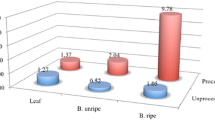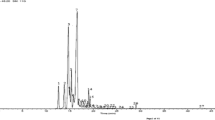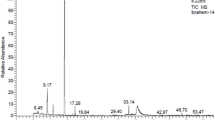Abstract
Insecticidal activity of the essential oils (EOs) isolated from Tagetes lucida, Lippia alba, Lippia origanoides, Eucalyptus citriodora, Cymbopogon citratus, Cymbopogon flexuosus, Citrus sinensis, Swinglea glutinosa, and Cananga odorata aromatic plants, grown in Colombia (Bucaramanga, Santander), and of a mixture of L. alba and L. origanoides EOs were evaluated on Aedes (Stegomyia) aegypti Rockefeller larvae. The EOs were extracted by microwave-assisted hydrodistillation and characterized by gas chromatography–mass spectrometry (GC-MS). The main components of the EOs were identified using their linear retention indices and mass spectra. The lethal concentrations (LCs) of the EOs were determined between the third and fourth instar of A. aegypti. LC50 was determined by probit analysis using mortality rates of bioassays. All essential oils tested showed insecticidal activity. The following values were obtained for C. flexuosus (LC50 = 17.1 ppm); C. sinensis (LC50 = 20.6 ppm); the mixture of L. alba and L. origanoides (LC50 = 40.1 ppm); L. alba (LC50 = 42.2 ppm); C. odorata (LC50 = 52.9 ppm); L. origanoides (LC50 = 53.3 ppm); S. glutinosa (LC50 = 65.7 ppm); T. lucida (LC50 = 66.2 ppm); E. citriodora (LC50 = 71.2 ppm); and C. citratus (LC50 = 123.3 ppm). The EO from C. flexuosus, with citral (geranial + neral) as main component, showed the highest larvicidal activity.
Similar content being viewed by others
References
Abd SL, Yaakob H, Mohamed RZ (2013) Potential anti-dengue medicinal plants: a review. J Nat Med 67:677–689
Amer A, Mehlhorn H (2006a) Larvicidal effects of various essential oils against Aedes, Anopheles, and Culex larvae (Diptera, Culicidae). Parasitol Res 99:466–472
Amer A, Mehlhorn H (2006b) Repellency effects of forty-one essential oils against Aedes, Anopheles, and Culex mosquitoes. Parasitol Res 99:478–490
Amusan AA, Idowu AB, Arowolo FS (2005) Comparative toxicity effect of bush tea leaves (Hyptis suaveolens) and orange peel (Citrus sinensis) oil extract on larvae of the yellow fever mosquito Aedes aegypti. Tanzan Health Res Bull 7:174–178
Bakkali F, Averbeck S, Averbeck D, Idaomar M (2008) Biological effects of essential oils—a review. Food Chem Toxicol 46:446–475
Bassolé IH, Lamien-Meda A, Bayala B, Obame LC, Ilboudo AJ, Fransz C, Novak J, Nebié RC, Dicko MH (2011) Chemical composition and antimicrobial activity of Cymbopogon citratus and Cymbopogon giganteus essential oils alone and in combination. Phytomedicine 18:107–1074
Bhatt S, Gething PW, Brady OJ, Messina JP, Farlow AW, Moyes CL, Drake JM, Brownstein JS, Hoen AG, Sankoh O, Myers MF, Geroge DB, Jaenisch TJ, Wint GR, Simmons CP, Scott TW, Farrar JJ, Hay SI (2013) The global distribution and burden of dengue. Nature 496:504–507
Cárdenas EC, Riveros IT, Lugo LV (2013) Efecto insecticida de cuatro aceites esenciales sobre adultos de Aedes aegypti y Anopheles albimanus en condiciones experimentales. Entomotropica 28:1–10
Cavalcanti ESB, Morais SM, Lima MAA, Santana EWP (2004) Larvicidal Activity of essential oils from Brazilian plants against Aedes aegypti L. Mem Inst Oswaldo Cruz 99:541–544
Duque JEL, Navarro-Silva MA, Trejos ADY (2009) Simulando manejo de Aedes aegypti (Diptera: Culicidae) y sus efectos en una epidemia de dengue. Rev Colomb Entomol 35:66–72
Finney DJ (1971) Probit analysis. Cambridge University Press, 3rd edn. 174 p
Gleiser RM, Bonino MA, Zygadlo JA (2011) Repellence of essential oils of aromatic plants growing in Argentina against Aedes aegypti (Diptera: Culicidae). Parasitol Res 108:69–78
Grisales N, Poupardin R, Gomez S, Fonseca-Gonzalez I, Rason H, Lenhart A (2013) Temephos resistance in Aedes aegypti in Colombia compromises dengue vector control. PLoS Negl Trop Dis 7:1–10
Guzman MG, Hal-Stead SB, Artsob H, Buchy P, Farrar J, Gubler DJ, Hunsperger E, Kroeger A, Margolis HS, Martínez E, Nathan MB, Pelegrino JL, Simmons C, Yoksan S, Peeling RW. (2010). Dengue: a continuing global threat. Nat Rev Micro S7-S16, doi:10.1038/nrmicro2460
Hafeez F, Akram W, Suhail A, Knan MA (2010) Adulticidal action of ten citrus oils against Aedes albopictus (Diptera: Culicidae). Pak J Agric Sci 47:241–244
Harris AF, Rajatileka S, Rason H (2010) Pyrethroid resistance in Aedes aegypti from Grand Cayman. Am J Trop Med Hyg 83:277–284
Isman MB (2006) Botanical insecticides, deterrents, and repellents in modern agriculture and an increasingly regulated world. Annu Rev Entomol 51:45–66
Jaramillo GIR, Logan JG, Loza-Reyes E, Stashenko E, Moores GD (2012) Repellents inhibit P450 enzymes in Stegomyia (Aedes) aegypti. PLoS ONE 7:e48698. doi:10.1371/journal.pone.0048698
Karunamoorthi K, Ilango K (2010) Larvicidal activity of Cymbopogon citratus (DC) Stapf. and Croton macrostachyus Del. against Anopheles arabiensis Patton, a potent malaria vector. Eur Rev Med Pharmacol Sci 14:57–62
Kishore N, Mishra BB, Tiwari VK, Tripathi V (2011) A review on natural products with mosquitosidal potentials. In: Tiwari VK (ed) Opportunity, challenge and scope of natural products in medicinal chemistry, Kerala Research Signpost 335–365
Kumar A, Dutta GP (1987) Indigenous plant oils as larvicidal agent against Anopheles stephensi mosquitoes. Curr Sci 56:959–960
Laughlin CA, Morens DM, Cassetti MC, Denis AC, Martin JL, Whitehead SS, Fauci AS (2012) Dengue research opportunities in the Americas. J Infect Dis 206:1121–1127
Lima EP, Paiva ME, Araújo AP, Silva EVG, Silva UM, Oliveira LN, Santana AE, Barbosa CN, Neto CP, Goulart MO, Wilding CS, Ayres CFJ, Santos MAVM (2011) Insecticide resistance in Aedes aegypti populations from Ceará, Brazil. Parasit Vectors 4:1–12
Makhaik M, Narayan SN, Tewary DK (2005) Evaluation of anti-mosquito properties of essential oils. J Sci Ind Res 64:129–133
Manimaran A, Cruz MJJ, Muthu C, Vicent S, Ignacimuthu S (2012) Larvicidal and knockdown effects of some essential oils against Culex quinquefasciatus Say, Aedes aegypti (L.) and Anopheles stephensi (Listos). Adv Biosci Biotechnol 3:855–862
Mullai K, Jebanesan A, Pushpanathan T (2008) Effect of bioactive fractions of Citrullus vulgaris Schrad. leaf extract against Anopheles stephensi and Aedes aegypti. Parasitol Res 102:951–955
Murugan K, Kumar PM, Kovedan K, Amerasan D, Subrmaniam J, Hwang JS (2012) Larvicidal, pupicidal, repellent and adulticidal activity of Citrus sinensis orange peel extract against Anopheles stephensi, Aedes aegypti and Culex quinquefasciatus (Diptera: Culicidae). Parasitol Res. doi:10.1007/s00436-012-3021-8
Neiro LS, Olivero-Verbel J, Stashenko E (2010) Repellent activity of essential oils: a review. Bioresour Technol 101:372–378
Osmani Z, Sighamony S (1980) Effects of certain essential oils on mortality and metamorphosis of Aedes aegypti. Pesticides 14:15–16
Phasomkusolsil S, Soonwera M (2011) Comparative mosquito repellency of essential oils against Aedes aegypti (Linn.) Anopheles dirus (Peyton and Harrison) and Culex quinquefasciatus (Say). Asian Pac J Trop Biomed S113-S118
Ramar M, Paulraj MG, Ignacimutgu S (2013) Preliminary screening of plant essential oils against larvae of Culex quinquefasciatus Say (Diptera: Culicidae). Afr J Biotechnol 12:6480–6483
Rattan RS (2010) Mechanism of action of insecticidal secondary metabolites of plant origin. Crop Prot 29:913–920
Shaalan EAS, Canyon D, Faried MWY, Abdel-Wahab H, Mansour AH (2005) A review of botanical phytochemicals with mosquitocidal potential. Environ Int 31:149–1166
Silva WJ, Dória GA, Maia RT, Nunes RS, Carvalho GA, Blank AF, Alves PB, Marçal RM, Cavalcanti SC (2008) Effects of essential oils on Aedes aegypti larvae: alternatives to environmentally safe insecticides. Bioresour Technol 99:3251–3255
Simmons CP, Farrar JJ, Vinh Chau V, Wills B (2012) Current concepts Dengue. N Engl J Med 366:1423–1432
Stashenko EE, Jaramillo BE, Martínez JR (2004) Comparison of different extraction methods for the analysis of volatile secondary metabolites of Lippia alba (Mill.) N.E. Brown, grown in Colombia and evaluation of its in vitro antioxidant activity. J Chromatogr A 1025:93–103
Tennyson S, Samraj DA, Jeyasundar D, Chalieu K (2013) Larvicidal efficacy of plant oils against the dengue vector Aedes aegypti (L.) (Diptera: Culicidae). Middle East J Sci Res 13:64–68
Warikoo R, Ray A, Sandhu JK, Samal R, Wahab N, Kumar S (2012) Larvicidal and irritant activities of hexane leaf extracts of Citrus sinensis against dengue vector Aedes aegypti L. Asian Pac J Trop Biomed 2:152–155
(WHO)-World Health Organization (1981) Instructions for determining the susceptibility or resistance of mosquito larvae to insecticides. Geneva. 6 p
(WHO)- World Health Organization (1992) Vector resistance to pesticides. Fifteenth report of the WHO Expert Committee on Vector Biology and Control. WHO Tech Rep Ser 818:1–62
Acknowledgments
This study was conducted thanks to the research support program of the “Vicerrectoría de Investigación of the Universidad Industrial de Santander for Project 5680” and the contributions of the “Patrimonio Autónomo, Fondo Nacional de Financiamiento para la Ciencia, Francisco Jose de Caldas,” contract RC-0572-2012- Bio-Red -CENIVAM. We would also like to thank Dr. German Eduardo Matiz of the University of Cartagena Colombia, for providing the Rockefeller strain.
Author information
Authors and Affiliations
Corresponding author
Rights and permissions
About this article
Cite this article
Vera, S.S., Zambrano, D.F., Méndez-Sanchez, S.C. et al. Essential oils with insecticidal activity against larvae of Aedes aegypti (Diptera: Culicidae). Parasitol Res 113, 2647–2654 (2014). https://doi.org/10.1007/s00436-014-3917-6
Received:
Accepted:
Published:
Issue Date:
DOI: https://doi.org/10.1007/s00436-014-3917-6




